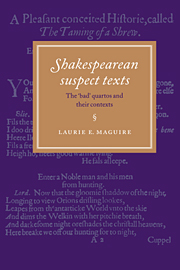2 - The rise of the New Bibliography
Published online by Cambridge University Press: 19 October 2009
Summary
‘Nature and Nature's laws lay hid in night:
God said, Let Newton be! and all was light.’
– It did not last: the Devil howling Ho!
Let Einstein be!, restored the status quo.
W.W.GregTo this science of textual criticism must certainly be joined a sketch of the historical development of the study of our language and literature, and this not as a means of commemorating those who have been before us, but for the purpose of criticising their methods, and evaluating their statements.
R.B.McKerrowIn his presidential address to the Bibliographical Society in 1930, W. W. Greg reviewed the achievements of the textual colleagues with whom he was associated ‘in what will perhaps one day be recognised as a significant critical movement’. That critical movement came to be known as ‘New Bibliography’ and, as represented in editorial practice and textual journals in Britain and North America, assumed a significance and supremacy which Greg's modest prolepsis could scarcely have envisaged. With its emphasis on the material book rather than its literary content, and its formidable array of technical tools (to say nothing of vocabulary) for analysing textual evidence, the New Bibliography heralded a brave new world in editorial epistemology and procedure. By analysing all aspects of textual transmission, and formulating principles for editing, Greg and his colleagues aimed to systematise the editing of Elizabethan drama, thus delivering Shakespeare and his readers from the inaccuracies, eclecticism, and taste of previous editors.
- Type
- Chapter
- Information
- Shakespearean Suspect TextsThe 'Bad' Quartos and their Contexts, pp. 21 - 72Publisher: Cambridge University PressPrint publication year: 1996



